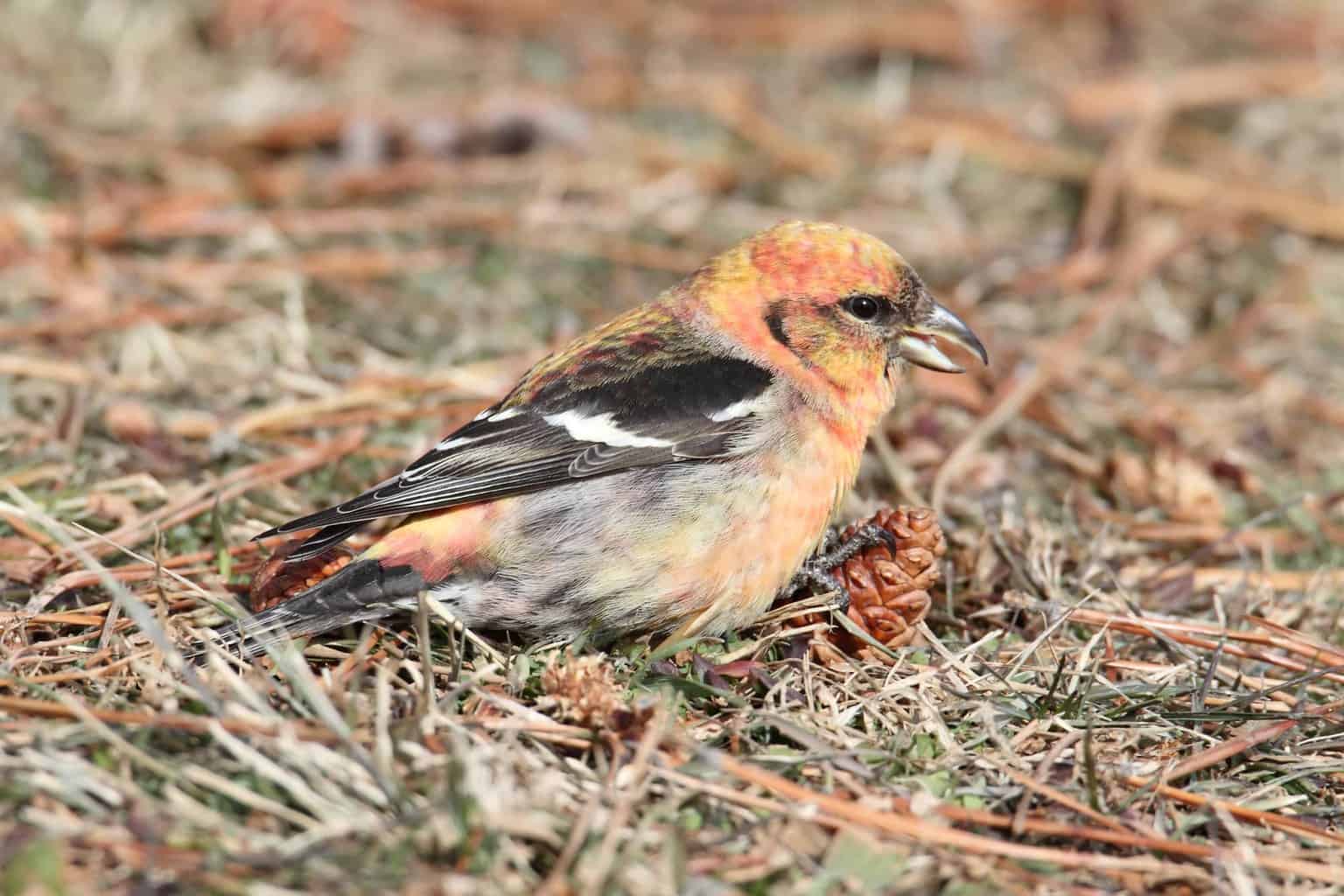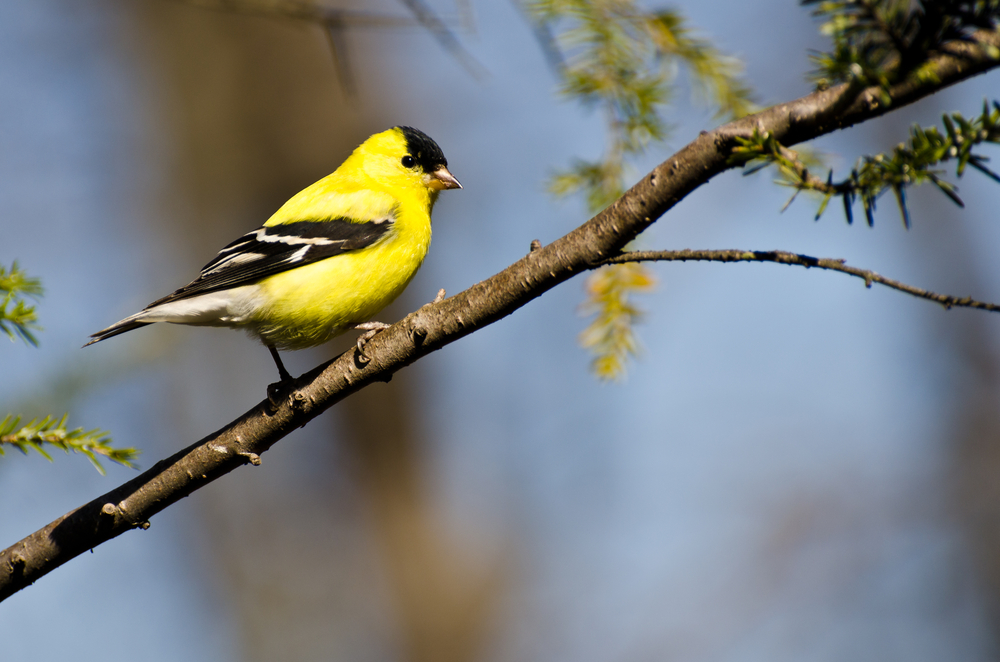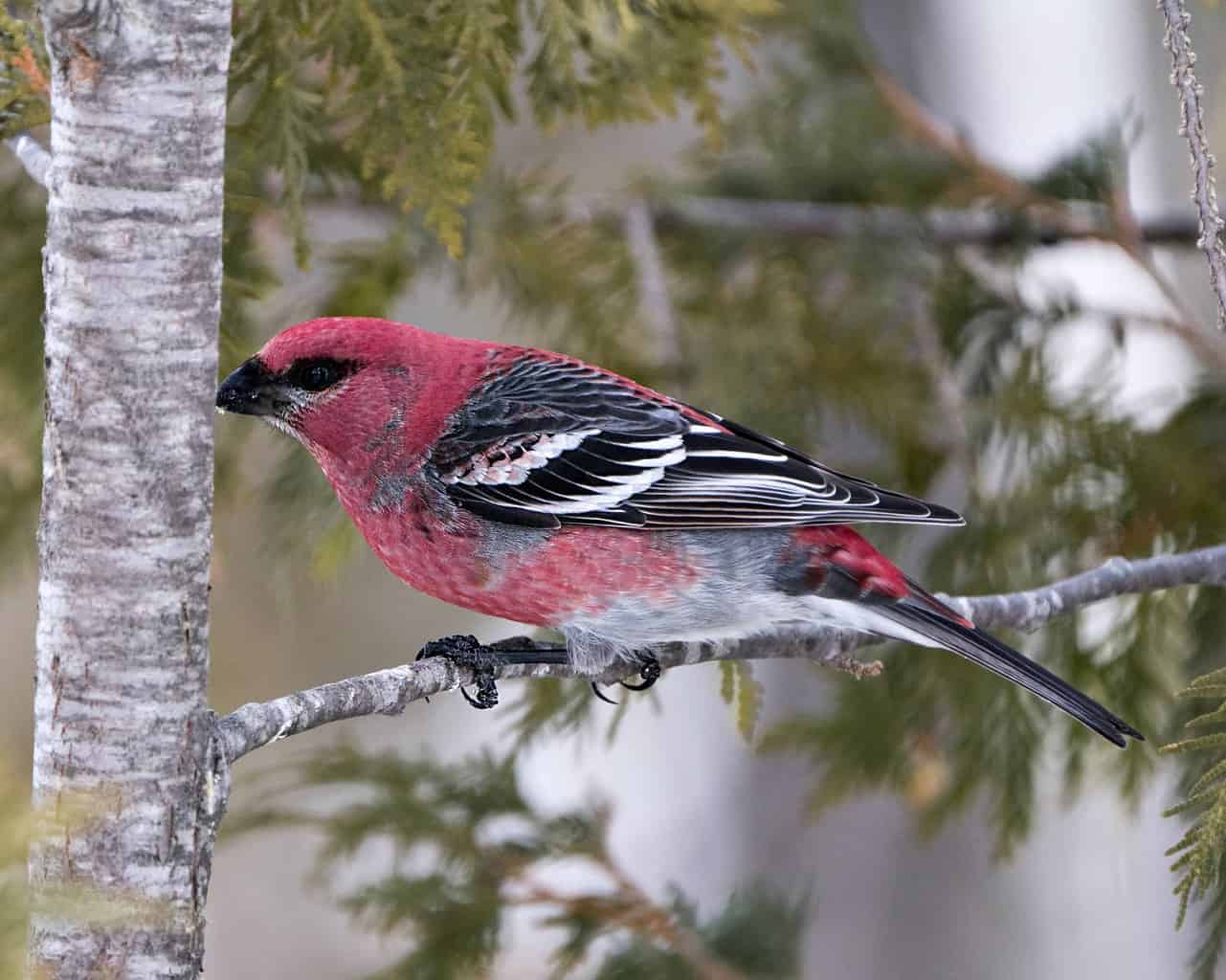It is dominated by the Green Mountains which give it its nickname and is home to Lake Champlain, one of North America’s largest lakes.
New Hampshire’s western neighbor is also known for its mild summers, dreamlike autumns, and frosty winters.
Here, the ruby-throated hummingbird appears just before summer taking off to warmer climes at the beginning of fall.
Blue jays however remain all year round, especially in the presence of abundant food. And there are finches too — lots of them.
Out of 388 bird species in Vermont, ten of them belong to this category of passerines. And if you have ever wanted to know just what they look like and when and where they live in the Green Mountain State, you’ll be able to find out right here.
Red Crossbill

- Scientific Name: Loxia curvirostra
- Length: 7.9 inches
- Weight: 2 ounces
- Wingspan: 12 inches
Red crossbill males are covered in red coppery plumage which may be faintly barred just below the nape. Females, however, are generally a light bronze on their chests, abdomens, and upper surfaces.
Both male and female red crossbills possess a crisscrossed beak with which they open pine cones. They also have dark eyes and brown wings.
This finch species is rather gregarious and is particularly partial to berries, insects, the buds and seeds of firs, hemlocks, pines, and salt.
The range of these passerines extends through central Canada and the western and southwestern United States including Arizona, California, Montana, New Mexico, Nevada, Utah, and Wyoming. Small populations can also be found in the eastern United States. Red crossbills can be found in Vermont’s upper half all year round, as a result.
White-Winged Crossbill

- Scientific Name: Loxia leucoptera
- Length: 6 – 7 inches
- Weight: 1 – 1.4 ounces
- Wingspan: 13 inches
Males of this species can be distinguished from their red crossbill cousins by their red coloring, which occasionally darkens beneath the nape.
Their wings covered in black feathers which turn white at the edges, are another distinguishing factor. Females are covered in grayish-brown plumage with hints of olive at the chest, face, and head.
Like red crossbills, both males and females have a criss-crossed beak with which they prise conifer cones open.
This species is especially fond of spruce cones and members are quite willing to fly from one end of Canada to another in search of their favorite food sources. They are also quite willing to travel south too. Their southern winter range extends as far as Colorado in the southwest and Virginia in the east. As a result, white-winged crossbills can be found throughout Vermont during winter, albeit in low numbers.
House Finch

- Scientific Name: Haemorhous mexicanus
- Length: 5 – 6 inches
- Weight: 0.6 – 0.9 ounces
- Wingspan: 8 – 10 inches
House finches can be recognized by plumage which is mostly brown with hints of white blended in, and mainly white at the chest streaked with brown. Males also exhibit a splash of rose at the face and the chest and even the rump.
The range of this hardy, adaptable species extends throughout the United States (Florida’s southernmost tip and the Texas Gulf Coast, are the sole exceptions) and house finches can be spotted in Vermont all year round throughout the state.
Purple Finch

- Scientific Name: Haemorhous purpureus
- Length: 4.7 – 6.3 inches
- Weight: 0.63 – 1.10 ounces
- Wingspan: 10 inches
In spite of a close resemblance to the house finch, this comparatively docile species can be recognized by its head which is more bulbous.
Both genders are covered in brown and white plumage, suffused with pink in the case of the male particularly at the head.
Females exhibit brown streaks which are more clearly defined compared to those of female house finches.
Purple finches breed in Canada but can also be found along the western coast of the United States and the northeastern United States. As a result, they can be found throughout the state of Vermont, all year round as it falls within their eastern range.
American Goldfinch

- Scientific Name: Spinus tristis
- Length: 4.3 – 5.5 inches
- Weight: 0.4 – 0.7 ounces
- Wingspan: 7.5 – 9 inches
Known for being rather nimble, gregarious, and monogamous, by nature, American goldfinches are also especially adaptable and are equally comfortable in urban areas or out in the wild.
They are also the only members of their species to undergo molting twice a year. Males of the species exhibit a black cap at the crown which contrasts with their bright golden plumage, and dark wing feathers edged with white.
However once the breeding season is over, they swap this beautiful array of colors for a rather subdued olive.
Female American goldfinches are olive and brown with touches of yellow; their wings also possess the same pattern as those of their male counterparts.
This species has a range which extends from Canada and covers the United States in its entirety. As a result, American goldfinches are a regular occurrence in every part of Vermont, all year round.
Evening Grosbeak

- Scientific Name: Hesperiphona vespertina
- Length: 6 – 9 inches
- Weight: 1.4 – 3 ounces
- Wingspan: 12 – 14 inches
Male evening grosbeaks are easy to spot at any feeder with their striking plumage which starts out dark brown at the head, progressively blending with yellow so that it turns bronze at the throat, and a dusky yellow at the breast and undersurface. That beautiful coloring is further highlighted by a “W” shaped yellow bar above the eyes, and a wedge of white at the center of their wings, which turn black at their outer edges.
Evening grosbeaks can be found in Vermont all year round although they are a rather rare occurrence.
They are found in higher concentrations to the north from British Columbia to Nova Scotia. This range also extends to Washington, northern Oregon, northern and eastern Idaho, and eastern Montana and Wyoming. They can also be found as far south as Florida and even Mexico.
Pine Grosbeak

- Scientific Name: Pinicola enucleator
- Length: 9 inches
- Weight: 2 – 3 ounces
- Wingspan: 13 inches
Other than their stout size, pine grosbeaks are pretty distinct from evening grosbeaks. In place of yellow, bronze, and brown, males of this species are covered in a beautiful red, with a barred effect beneath the nape. Their eyes and beaks are black, as are their wings and tails. Their wing feathers pale towards their extremities creating a beautiful contrast.
The species is especially fond of spruce and fir trees although its members swap this preference for crab apple and mountain ash with the arrival of winter.
Pine grosbeaks are also known for withstanding human proximity with a remarkable degree of tolerance. Their range extends from Alaska, through northern Yukon and the west and the south of the Northwest Territories, passing through Manitoba, Ontario, and Quebec.
It also includes the western part of the United States and its southwest, although pine grosbeaks can also be found all the way to the Atlantic Coast as far south as Pennsylvania. However, they are rare visitors to the eastern United States and are rarely found in Vermont.
Common Redpoll

- Scientific Name: Acanthis flammea
- Length: 4.5 – 5.5 inches
- Weight: 0.4 – 0.5 ounces
- Wingspan: 8 – 9 inches
Small, compact, and energetic, common redpolls can be recognized by their darkly streaked plumage, dark red patches at their crowns, and breasts flushed with red.
These little frost-resistant finches can be found in thickets, on the borders of forests, and in fields. They are especially fond of alders, birches, and larches.
Common redpolls are rather nimble and gregarious too. Their breeding grounds extend from northern Alaska through Yukon, and the Northwest Territories, to Quebec.
They can also be found in these states all year round and in decreasing concentrations further south.
Common redpolls can be found in winter throughout Vermont. They can also be found during the season in Washington, Idaho, Montana, Wyoming, the Dakotas, and as far east as Massachusetts on the Atlantic Coast.
Hoary Redpoll

- Scientific Name: Acanthis hornemanni
- Length: 5 – 5.5 inches
- Weight: 0.40 – 0.70 ounces
- Wingspan: 8 – 10 inches
Members of this species may be considered slightly larger and paler versions of common redpolls which are also imbued with a greater degree of frost resistance.
Like their smaller relatives, they sport a dark red patch on the crown. However, their plumage lacks the prominent streaking and dark brown found in common redpolls.
Hoary redpolls breed in northern Alaska as well as islands in the Arctic Ocean. They can also be found in northern Canada moving southwards in winter.
These beautiful finches can additionally be found as far south as New York, and as a result, are rare visitors to the state of Vermont.
Pine Siskin

- Scientific Name: Spinus pinus
- Length: 4.3 – 5.5 inches
- Weight: 0.4 – 0.6 ounces
- Wingspan: 7 – 9 inches
Renowned for being especially nimble, pine siskins’ main distinguishing features include plumage which is especially striated at the breast and brown at the head. Their wing and tail feathers are black-edged with yellow creating a contrasting effect.
Pine siskins can be found in forests, urban areas, and swamps, and enjoy feeding on aphids, buds, nectar, and the seeds of alders, birches, thistles, and sunflowers.
These gregarious finches can be found in Canada and throughout the United States. They can be found in Vermont all year round.
Conclusion
Vermont’s natural beauty and abundance of flora make it a natural haven for wildlife including those of the avian variety.
From the house finch which can be found all year round, to the more elusive hoary redpoll, and the rather mild-mannered pine grosbeak, there are endless opportunities for birdwatchers to admire these beautiful songbirds.
Hence there can be no doubt that New York’s northern neighbor is an ideal location for fans of these multihued, gregarious, beautiful birds.

